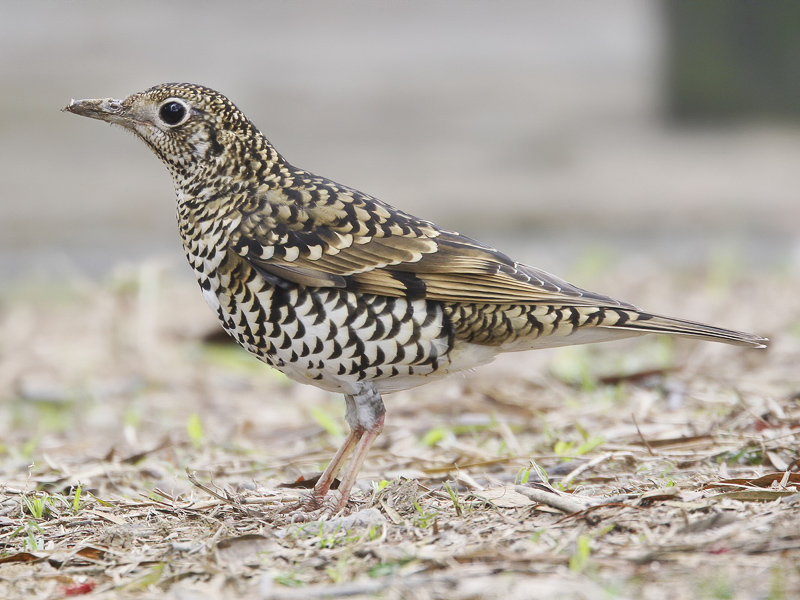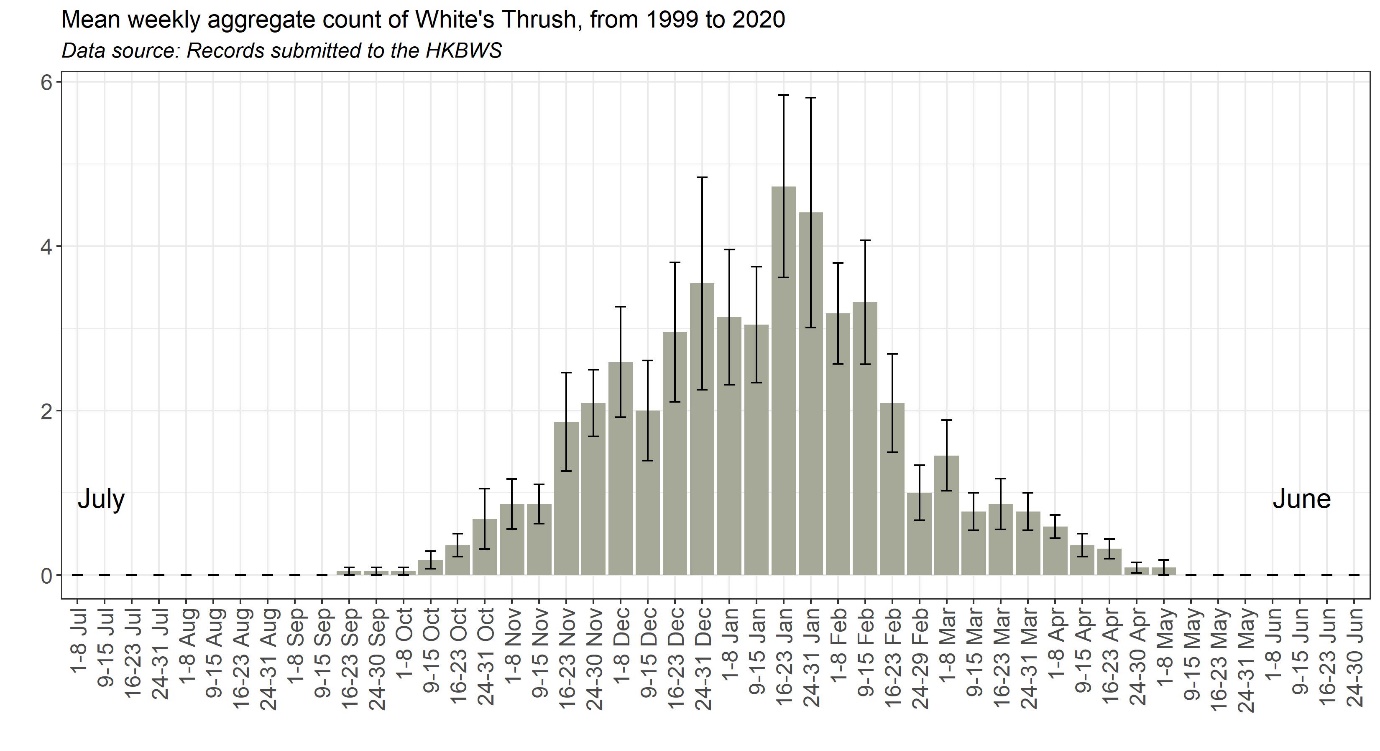White’s Thrush Zoothera aurea 懷氏地鶇
Category I. Uncommon winter visitor, scarce passage migrant.
IDENTIFICATION

Jan. 2010, Martin Hale.
Large distinctive thrush with variegated plumage, a mixture of buff brown and blackish above and whitish below with broad dark grey crescents on throat, chest and flanks. More often flushed than seen on the ground. In flight appears large with broad-based, pointed wings and shows white tail corners (more easily seen when flying away), pale bases to flight feathers on upperwing, broad white bands on underwing coverts separated by dark band (not often seen) and broad, paler brown and more uniform rump.
VOCALISATIONS
Rarely heard to vocalise. Flight call is a high-pitched, sharply downslurred ‘tsee’, similar to other thrushes but not so buzzing.
Also, a Turdus-like alarm call that is quieter and less explosive.
And a low, buzzing call.
DISTRIBUTION & HABITAT PREFERENCE
Occurs in forest, forest edge, fung shui woodland, urban parks and open grassy areas such as lawns, picnic areas and golf courses that are adjacent to arboreal cover. Seems to favour damper areas of the forest. There are very few records from Tai Mo Shan, suggesting a strong preference for lowland areas.
Recorded in 3.5% of 1km squares in the winter atlas of 2001-05, this declined to 1.5% in the 2016-19 survey, indicating White’s Thrush is now less widespread than formerly. Sharp declines appear to have occurred on Lantau, HK Island and Sai Kung, and a less marked decrease in northeast New Territories. The reasons for declines in these areas are unknown.
OCCURRENCE
First recorded only in 1953 when one was present during 11-18 April (Dove and Goodhart 1955), possibly reflecting the lack of mature forest habitat in HK in the middle part of the 20th Century. The wintering population is largely established by the third week of November and remains until the third week of February (Figure 1). First arrivals can be much earlier, however, with the earliest on record being 23 September 2012, with the next earliest on 30 September 2019. However, it remains rare in October, with only 26 records in eleven years during 2003-2020. In a similar vein, there is a rather long tail of records after the February departure of the bulk of the wintering population, with the latest on record occurring on 8 May 2005. Observations on Po Toi indicate migrants pass through during October and from the middle of March.
Influxes may occur during cold weather in some winter periods (Figure 2). The most notable influx occurred in early 1995 during what was already an excellent winter for this species. In the last week of January and the first week of February at least 45 different birds were reported from 17 widespread sites, a considerable increase on the already good numbers present earlier in the winter (27 at 12 sites in the first two weeks of January). The winter periods 2003/04 and 2013/14 also saw higher numbers present in HK. The apparent increase in numbers recorded this century is likely due to increased observer activity given the decline in distribution noted above; a decline has also been noted by long-term resident observers.
Sometimes birds remain faithful to a site, and it is not uncommon for what are presumed to be the same individuals to be present for two months or more, the longest being up to two at the former Victoria Barracks on HK Island from 1 January to 30 April 1988.
BEHAVIOUR, FORAGING & DIET
Generally solitary, rather shy and unobtrusive despite its size. Usually first seen as it silently flies away after being flushed. In cold weather, however, becomes much more obvious and small groups of birds may be seen foraging in the open. Forages on the ground, rarely if ever seen in fruiting trees.
RANGE & SYSTEMATICS
Breeds from east European Russia east through southern Siberia and north Mongolia to Sakhalin and Japan; winters in from east China to Indochina, the northern Philippines and north Borneo (del Hoyo et al. 2020). In China breeds in the northeast and winters south of the Yellow River (Liu and Chen 2020).
The nominate subspecies breeds from east European Russia to east Siberia and north Mongolia, while Z. a. toratugumi breeds from southeast Siberia through Sakhalin to Japan. It would appear the latter taxon is more likely to occur in HK based on occurrence of other migratory passerines here.
CONSERVATION STATUS
IUCN: Least Concern. Population trend decreasing.
Figure 1.

Figure 2.

Dove, R. S. and H. J. Goodhart (1955). Field observations from the Colony of Hong Kong. Ibis 97: 311-340.
del Hoyo, J., N. Collar, D. A. Christie, and G. M. Kirwan (2020). White's Thrush (Zoothera aurea), version 1.0. In Birds of the World (S. M. Billerman, B. K. Keeney, P. G. Rodewald, and T. S. Schulenberg, Editors). Cornell Lab of Ornithology, Ithaca, NY, USA. https://doi.org/10.2173/bow.scathr2.01
Liu, Y. and Y. H. Chen (eds) (2020). The CNG Field Guide to the Birds of China (in Chinese). Hunan Science and Technology Publication House, Changsha.

